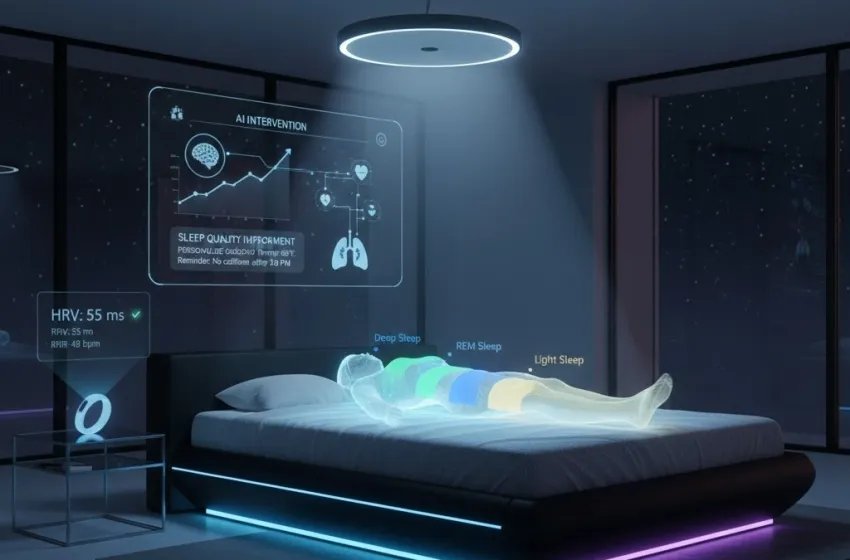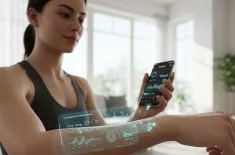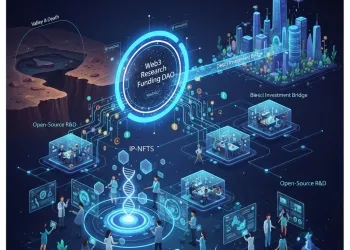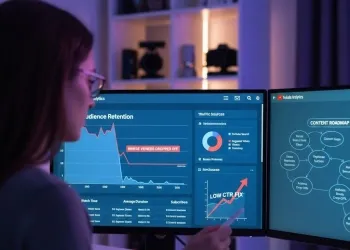Learn how smart devices and AI intervention use sleep stage tracking to deliver personalized sleep coaching for massive sleep quality improvement.
Introduction: The Revolution in Rest
Sleep is no longer viewed as a passive break from life but as a critical, non-negotiable pillar of health, recovery, and peak performance. Yet, for millions globally, achieving consistent, high-quality sleep remains a nightly struggle. This challenge has fueled an explosive market for advanced technologies that promise to not just measure our sleep, but actively fix it. We are witnessing a profound shift in the healthcare and wellness sectors, driven by sophisticated sleep health tech. This new generation of tools moves beyond simple wrist-worn counters to become true personal sleep consultants.
The key to this transformation lies in the fusion of highly sensitive sensors and powerful artificial intelligence. Early iterations of sleep trackers provided interesting, yet often unactionable, data—telling you only how long you slept. Today, smart devices are complex monitoring systems. They utilize a diverse array of biometrics to break down the nocturnal cycle, performing granular sleep stage tracking that rivals clinical equipment. However, the true game-changer is the ability to leverage that detailed data for immediate, dynamic improvement.
This new paradigm is defined by AI intervention. Instead of merely reporting a problem, these systems use algorithms to diagnose the root cause of a poor night's rest and immediately suggest or implement a fix. This is the essence of personalized sleep coaching—a constantly evolving feedback loop tailored to the user’s specific physiology and environment. The ultimate goal of this technological revolution is not just to track, but to deliver measurable, sustainable sleep quality improvement, making restorative sleep an accessible reality for everyone. The rise of digital therapeutics and remote patient monitoring underscores the massive shift this technology represents in modern health.
The Foundation: Precision Sleep Stage Tracking
The journey to effective sleep intervention begins with precise monitoring. Traditional consumer trackers relied primarily on actigraphy, which tracks gross body movement to estimate sleep time. While simple, this method is fundamentally flawed, often mistaking a quiet period of wakefulness for actual sleep. Modern sleep health tech has replaced this with a multi-sensor approach, providing detailed sleep stage tracking that is crucial for any meaningful AI intervention.
A. Beyond Movement: Sensors and Biometrics
Advanced smart devices, ranging from rings and watches to under-mattress mats, employ a combination of sensors to capture physiological signals that directly correlate with the brain activity defining the sleep cycle. The most common include:
- Photoplethysmography (PPG): Measures changes in blood volume, allowing for continuous heart rate and Heart Rate Variability (HRV) monitoring. HRV, a subtle metric, is a powerful indicator of nervous system activity, helping to distinguish between light and deep sleep stages.
- Accelerometers: Still used, but now combined with other data to track micro-movements associated with transitioning between stages or restless wakefulness. This data is critical for filtering out non-sleep movement.
- Temperature Sensors: Track minute changes in skin and core body temperature, which naturally fluctuates across the sleep cycle. This aids in the highly accurate identification of REM sleep, as body temperature regulation becomes less efficient during this phase.
- Respiratory Rate: Measured through subtle chest and abdominal movements (via ballistocardiography in under-mattress devices) or through PPG. This metric is vital for detecting breathing disturbances, which are semantically linked to conditions like sleep apnea.
B. The Science of Stages
The accuracy of sleep stage tracking is what enables high-quality AI intervention. A poor night is rarely about just the total duration; it’s about the *architecture*—the percentage of time spent in the key restorative phases. Sleep architecture analysis is a key informational search intent related to this technology:
- Light Sleep: Preparation for deeper stages, crucial for general body functions and easing transition into deeper rest.
- Deep Sleep (Slow-Wave Sleep - SWS): The most physically restorative stage, essential for growth hormone release, cellular repair, and short-term memory consolidation. Low Deep Sleep is a prime target for effective personalized sleep coaching strategies.
- REM Sleep: Critical for emotional regulation, procedural memory, and learning. It is often characterized by the body's closest approximation to wakefulness in terms of brain activity.
By using the deep biometric data to map these phases, the sleep health tech moves past a simple time report to produce a clinically relevant sleep architecture analysis. This precise data is then fed into machine learning algorithms, which are the basis for the next phase of the revolution: personalized intervention. The high fidelity of this tracking means the system can spot subtle deviations—like a persistent lack of Deep Sleep—and link it back to pre-sleep behaviors or environmental factors, paving the way for proactive measures and genuine sleep quality improvement.
The Engine of Change: AI Intervention and Digital Therapeutics
The transition from passive monitoring to active management is driven entirely by AI intervention. This is where machine learning transforms raw physiological signals into dynamic, actionable solutions. The AI acts as a continuous analyst, processing millions of data points every night—from HRV and room temperature to caffeine intake logged during the day—to determine the precise cause-and-effect relationships governing an individual's rest. This complex pattern recognition is essential to create effective digital therapeutics.
A. What is AI Intervention?
AI intervention is fundamentally the shift from descriptive data ("You slept poorly") to prescriptive action ("You slept poorly because your room temperature spiked at 3 AM; here is how we fix it"). The AI creates a holistic, dynamic model of the user’s circadian rhythm, sleep debt, and autonomic nervous system. It identifies complex patterns that human analysis often misses, such as a subtle correlation between a late afternoon stress event and subsequent fragmented REM sleep. This predictive and diagnostic capability allows the technology to offer far more than generic sleep hygiene tips; it delivers highly specific recommendations tailored for maximum sleep quality improvement. The semantic search queries 'how AI diagnoses sleep disorders' and 'AI personalized advice' are satisfied by this function.
B. Real-time Biofeedback: Dynamic Environmental Adjustments
The most advanced forms of AI intervention happen *in the moment*—while the user is sleeping, eliminating the need for conscious behavioral change. This is known as real-time biofeedback. Examples include smart beds (a form of advanced smart devices) that use built-in sensors to monitor core body temperature. If the AI detects a dip in Deep Sleep quality, it can instantly and subtly adjust the mattress temperature, cooling it down to prolong the deep sleep phase, which is highly sensitive to thermal fluctuations. Similarly, some ambient sleep health tech uses microphones to detect snoring or breathing irregularities. The AI can then trigger a gentle vibration or movement to encourage a change in sleeping posture, a crucial intervention for positional obstructive sleep apnea.
C. The Role of Machine Learning in Predictive Sleep Coaching
Machine Learning (ML) is the brain behind personalized sleep coaching. ML algorithms ingest weeks or months of sleep stage tracking data alongside lifestyle factors (exercise logs, meal times, daylight exposure) to build highly accurate predictive models. These models allow the system to forecast the next night's sleep quality and potential disruptions. For example, if the AI notices that a user’s Deep Sleep is consistently optimized when they finish vigorous exercise exactly four hours before bed, it can send a proactive reminder or modify the user's daily schedule—a core function of effective personalized sleep coaching. This predictive analytics layer helps manage the user's sleep debt and ensures optimal timing for naps and bedtimes, making the guidance extremely relevant and adherence more likely. This longitudinal data analysis elevates consumer technology towards the realm of 'precision sleep health'.
Advanced Devices and Apps: The Ecosystem of Intervention
The modern sleep health tech ecosystem is rich with smart devices and applications, each specializing in different data collection and intervention methods. This variety ensures that users can find a solution that fits their comfort level, from subtle wearables to non-contact environmental monitors, all focused on driving sleep quality improvement.
A. Wearables (Oura, Whoop): Micro-Data for Predictive Health
Wearable smart devices like the Oura Ring and WHOOP band have become incredibly popular, offering highly precise sleep stage tracking from the convenience of the finger or wrist. These devices excel at capturing micro-data essential for AI intervention:
- Heart Rate Variability (HRV): A key measure of recovery and stress. A rising HRV during sleep often correlates with better recovery. The AI uses this to calculate a daily “Readiness” or “Recovery” score, providing a critical piece of personalized sleep coaching that dictates appropriate daily activity levels.
- Resting Heart Rate (RHR) and Temperature: Baselines for these vital signs are established, and subtle deviations can flag the onset of illness or high physiological stress, prompting the AI to recommend increased rest or a lower-intensity workout.
This micro-data allows the **AI intervention** to give very specific advice, such as, “Your Readiness Score is low today due to reduced Deep Sleep, suggesting you prioritize a 15-minute guided relaxation session and aim for 30 minutes of extra sleep opportunity tonight.”
B. Non-Wearables (Smart Beds, Sleep Mats): Contactless Comfort and Environmental Control
For users who prefer no contact while sleeping, devices integrated into the bedroom environment offer seamless monitoring. Under-mattress sensors (like Withings Sleep Analyzer) or smart speakers monitor breathing, heart rate, and movement without physical contact. The most transformative non-wearable smart devices are smart beds, which provide immediate AI intervention by actively managing the sleep environment.
- Dynamic Temperature Adjustment: Systems like the Eight Sleep Pod Pro can heat or cool the mattress based on the AI's detection of a user entering deep or REM sleep, maximizing sleep efficiency and sleep quality improvement via thermal regulation.
- Acoustic and Light Integration: These systems can dim smart lights at a specified wind-down time and use adaptive soundscapes—pink or white noise tailored in real-time to the depth of sleep recorded by the sleep health tech—to mask environmental noise and prevent unwanted arousal.
C. Digital Therapeutics (Sleepio): Clinically Validated Personalized Sleep Coaching
Perhaps the most significant advancement is the rise of digital therapeutics for insomnia, often delivered through apps like Sleepio or Somryst. These platforms deliver Cognitive Behavioral Therapy for Insomnia (CBT-I), which is the empirically supported clinical treatment, in a scalable, accessible format. The program constitutes true personalized sleep coaching:
- The app uses AI intervention to guide users through personalized sessions based on their sleep stage tracking data and their daily sleep diary entries.
- It employs sleep restriction and stimulus control techniques tailored to the individual's specific patterns of wakefulness. By providing a structured, guided program, this digital sleep health tech ensures the intervention is optimized to achieve verifiable sleep quality improvement without the side effects of prescription medication. The FDA-clearance of some of these apps demonstrates their clinical potential.
The Outcome: Achieving Lasting Sleep Quality Improvement
The ultimate metric for this sophisticated sleep health tech is tangible, lasting sleep quality improvement. This improvement is not just about feeling less tired; it profoundly impacts the user’s physical, cognitive, and metabolic health. When AI-driven sleep stage tracking identifies a critical deficit in Deep Sleep, the subsequent AI intervention—whether through environmental control or personalized sleep coaching—is designed to lengthen and consolidate that restorative phase. This strategic approach yields demonstrable health benefits:
- Cognitive Function: Adequate REM and Deep Sleep are crucial for memory consolidation, learning, and executive functions like problem-solving. Improved sleep architecture directly translates to better daytime focus and mental acuity, appealing to the 'performance optimization' intent of many users.
- Metabolic and Immune Health: Consistent, quality sleep helps regulate hormones (including cortisol and those related to appetite, such as ghrelin and leptin) and strengthens immune response. By stabilizing sleep patterns, smart devices contribute to long-term chronic disease prevention and management.
The measurable effectiveness of this technology is found in the millions of hours of aggregated data showing real-world results: users reducing their Sleep Onset Latency (time to fall asleep), decreasing the frequency of nighttime awakenings, and consistently achieving higher scores on recovery metrics. The continuous nature of the data collected by smart devices allows users to definitively link specific actions (e.g., stopping blue light exposure one hour before bed) to positive outcomes in their sleep stage tracking report, cementing healthy habits and ensuring the sleep quality improvement is sustained. This feedback loop empowers the user as an active participant in their own health management.
Challenges and The Future of Sleep Tech
Despite the rapid advances in sleep health tech, significant challenges remain. A key concern is the variation in accuracy between consumer-grade smart devices and the clinical gold standard, Polysomnography (PSG). While many devices offer strong correlation, the need for stringent clinical validation remains critical, especially when the AI intervention suggests a potential medical disorder like sleep apnea. Data privacy is another major factor; continuous, intimate monitoring of physiological data requires robust security protocols that comply with standards like HIPAA and GDPR.
The future of sleep health tech is moving rapidly toward a seamless, predictive, and holistic model. We can expect increasingly sophisticated sensor fusion—combining data from multiple non-wearable and wearable devices for superior sleep stage tracking accuracy. Future smart devices will communicate flawlessly with all home ecosystems, automatically adjusting light, sound, temperature, and even air quality to optimize sleep in real-time. This predictive approach—using long-term data gathered via AI intervention to proactively prevent a poor night before it even begins—is the next frontier, promising the most profound leap yet in total sleep quality improvement and ushering in an era of true precision sleep medicine.
Conclusion: Sleeping Smarter
The evolution of sleep health tech represents one of the most exciting advancements in personal wellness. By combining highly accurate sleep stage tracking with sophisticated AI intervention, modern smart devices are delivering truly effective personalized sleep coaching. They empower users to move past merely surviving on poor sleep to actively pursuing deep, restorative rest. The journey from simple tracker to AI-powered coach marks a profound turning point, guaranteeing that accessible, data-driven sleep quality improvement is now within reach for anyone seeking a healthier, more energized life. The era of sleeping smarter has officially begun, and the potential for a rested population is vast.




































